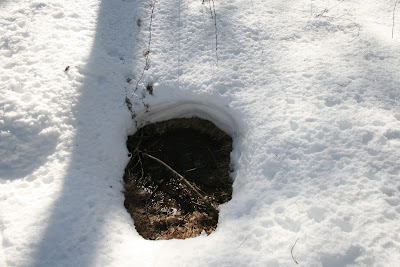This is the first year that I have seen a winter wren in winter. So far, I've seen two. I am surprised that this little wren - the smallest of our wrens - chose this winter to stay here in the north, so cold and snowy. A reference on New England Wildlife by DeGraaf and Yamasaki, says that the winter wren is not particularly hardy and does not winter north of Massachusetts. These wrens are apparently redrawing their winter range map.
A few weeks ago I saw a small brown bird with a stubby tail in the underbrush near the Exeter River. My first thought was a young bird, but of course this was the middle of winter, so not an option. This bird flew among small seeps and overturned root balls of big white pines. Last week I saw a similar bird in our back woods. I watched the bird make a rapid but short flight into a seep and then to an upturned tree root. I got a better look at this bird and realized that both sightings were of a winter wren. A small, dark brown bird with a stubby, upturned tail and a quick flight; a bird that flies furtively in the understory.
The winter wren is one of my favorite birds during the breeding season; its song is long and melodious. They live in conifer or mixed wood forests -- preferring spruce-fir forests -- usually near water. They hang around in the dense understory of upturned roots, fallen limbs, rock crevices, seeps, mossy hummocks along streams. You won't find them in a forest with an open understory lacking these features. Year-round, winter wrens glean insects from the ground. I think the wrens I saw were looking for insects in the woodlands seeps, like the one below that is in our back woods.
The open water in these woodland seeps (typically a few feet in diameter) attract other animals. A mammal entered this seep, then left muddy footprints when it climbed back out. I noticed this on several seeps in our woods. Maybe a squirrel or a raccoon. The snow is crusty, so track patterns are hard to read.
We need a fresh snowfall. Instead, tomorrow looks to be warm -- warmer than it's been for more than a month. Look (or more likely smell) for skunks - they are emerging from their winter dens about now. The warm temperatures on Valentine's Day will surely bring them out in search of mates.
Sunday, February 13, 2011
Subscribe to:
Post Comments (Atom)
Winter Solstice 2025
Cardinals and juncos are the first to arrive at the feeders. They fly in before first light. They are also the last to leave for their night...

-
The oldest known hardwood tree in North America--at 700 years old--is a black gum tree tucked away in a hummocky swamp in southern New Hamps...
-
On Sunday I brought home a fragment of an animal skeleton from Seapoint Beach. At first it looked like a baby dragon, but that's just to...
-
Big Island, Hawaii was fantastic. We are already planning another trip in 2020. Here are a few final thoughts and tips... Join Costco ...




No comments:
Post a Comment